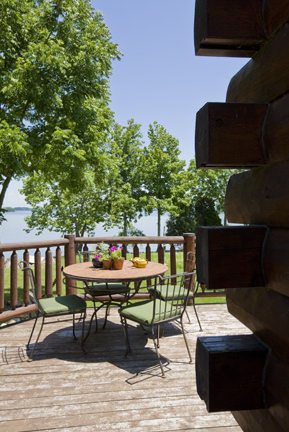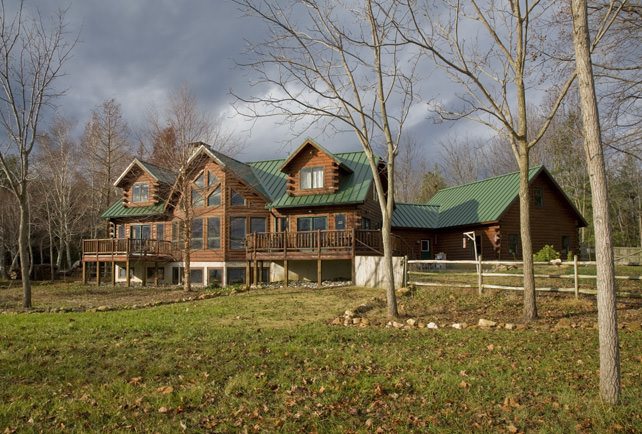 One thing we believe in at Katahdin is that our green initiatives are not only good for our planet but good for our company. One Maryland couple also kept faith with their moral convictions when selecting a log home manufacturer, and designing and building their beautiful log home on the banks of the Wye River.
One thing we believe in at Katahdin is that our green initiatives are not only good for our planet but good for our company. One Maryland couple also kept faith with their moral convictions when selecting a log home manufacturer, and designing and building their beautiful log home on the banks of the Wye River.
Tom and Courtney Leigh both believe in leaving their world better than when they found it. Tom is the Miles-Wye Riverkeeper, one of 19 Waterkeepers in the Chesapeake Bay region. The Waterkeeper® Alliance employs 200 Waterkeepers around the world with the goal of giving people a voice in stewardship of their water sources and watersheds. Courtney also works in the 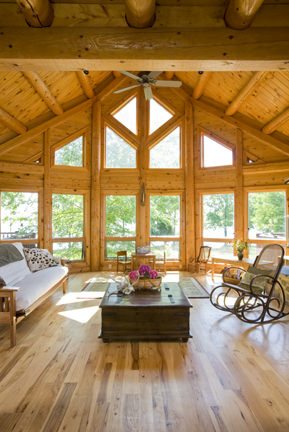 environmental field as the Education Specialist at Chesapeake Bay Environmental Center. “I want to make sure that my two daughters can see what I grew up with on the water,” Tom explained. He spent hours as a child on the water: catching crabs, fishing, boating and swimming.
environmental field as the Education Specialist at Chesapeake Bay Environmental Center. “I want to make sure that my two daughters can see what I grew up with on the water,” Tom explained. He spent hours as a child on the water: catching crabs, fishing, boating and swimming.
When Tom and Courtney decided to search for a log home company, they did some of the things that many Katahdin customers do: research companies online, read magazines and visit log home shows to narrow down the options that work best for them. “We started with a big funnel and attended a huge log home show,” Tom said. “We narrowed it down to cedar as a log species, because of the intrinsic value of cedar.” He noted that Katahdin’s sustainable forestry practices “struck a chord with us and was something we wanted to support as a consumer.”
And forestry was something that Tom had some background in, as the family land he planned to build on had been planted with native hardwoods, softwoods, and Christmas trees as a cash crop and certified tree farm. “We had a tremendous investment in the trees already, so it was important that we maintain our own sustainable forestry practices.”
They started their site preparation early by mapping out tree locations, identifying trees that would remain and those that would be transplanted. “We interviewed one builder who had little regard for trees except as obstacles to his construction,” Tom said. He didn’t make the cut. The builder the Leighs ultimately chose worked with them to locate the home among the trees that they had carefully planted without too many transplants. After 6-9 months of planning and transplanting during the appropriate seasons, the Leighs ended up benefitting from their woodland location. The builder also needed trees for mitigation at another site and the transplanted farm trees were moved there. 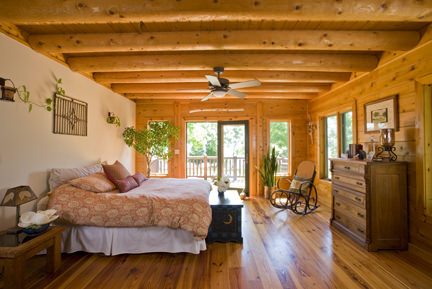
Water management was also an important element to planning the Leigh’s Katahdin Cedar Log Home, which is located 125 feet from the water’s edge. The river that Tom monitors had become contaminated with pollution from poor land use decisions.” Tom’s goal was to mitigate his proximity to the water with forward-thinking design. “We took advantage of the site’s natural configuration to filter water from the roof and driveways,” Tom said. He used a natural low point as a raingarden or bioretention area, and planted naturally hydrophilic trees and other vegetation to filter the runoff water before it returns to the river.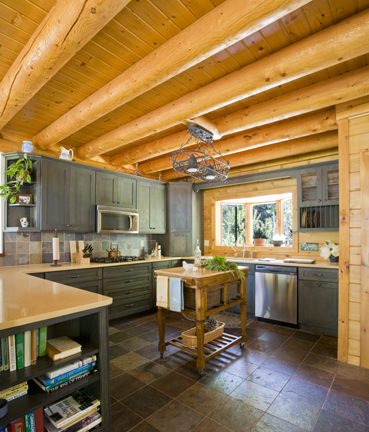 Nitrates are another major pollutant affecting the Wye River, so the Leighs installed a denitrifying septic system that uses new technology cut the nitrates from the septic water by 50% before it filters into the watershed. “The worst thing I could do as a Waterkeeper,” Tom said, “is to be a hypocrite. I want to be a demonstrator. I have a responsibility and a duty to show people how they can make a positive contribution to their river.” The design of his home reflects that mindfulness of how the home interacts with its surroundings.
Nitrates are another major pollutant affecting the Wye River, so the Leighs installed a denitrifying septic system that uses new technology cut the nitrates from the septic water by 50% before it filters into the watershed. “The worst thing I could do as a Waterkeeper,” Tom said, “is to be a hypocrite. I want to be a demonstrator. I have a responsibility and a duty to show people how they can make a positive contribution to their river.” The design of his home reflects that mindfulness of how the home interacts with its surroundings.
The home is also a stunning example to how to locate a log home to take advantage of beautiful views. The river and surrounding forest is just out side every room in the home, making the outdoors an integral part of the home’s ambiance.
And the home’s location makes it easy for Tom to get to the outdoor portion of his job. When the state legislature is in session, he spends his time lobbying for water stewardship and to protect the water rights of his constituents.
Tom has a visit to the Katahdin Cedar Log Home manufacturing facility in Oakfield, Maine, on his “bucket list.” He was so impressed with the best practices and utilizing the entire tree when first investigating log home companies. “I wish I had made the trip when we were first looking, but I’ll get up there soon!” he said.